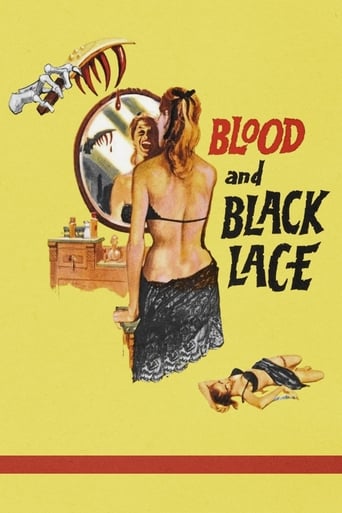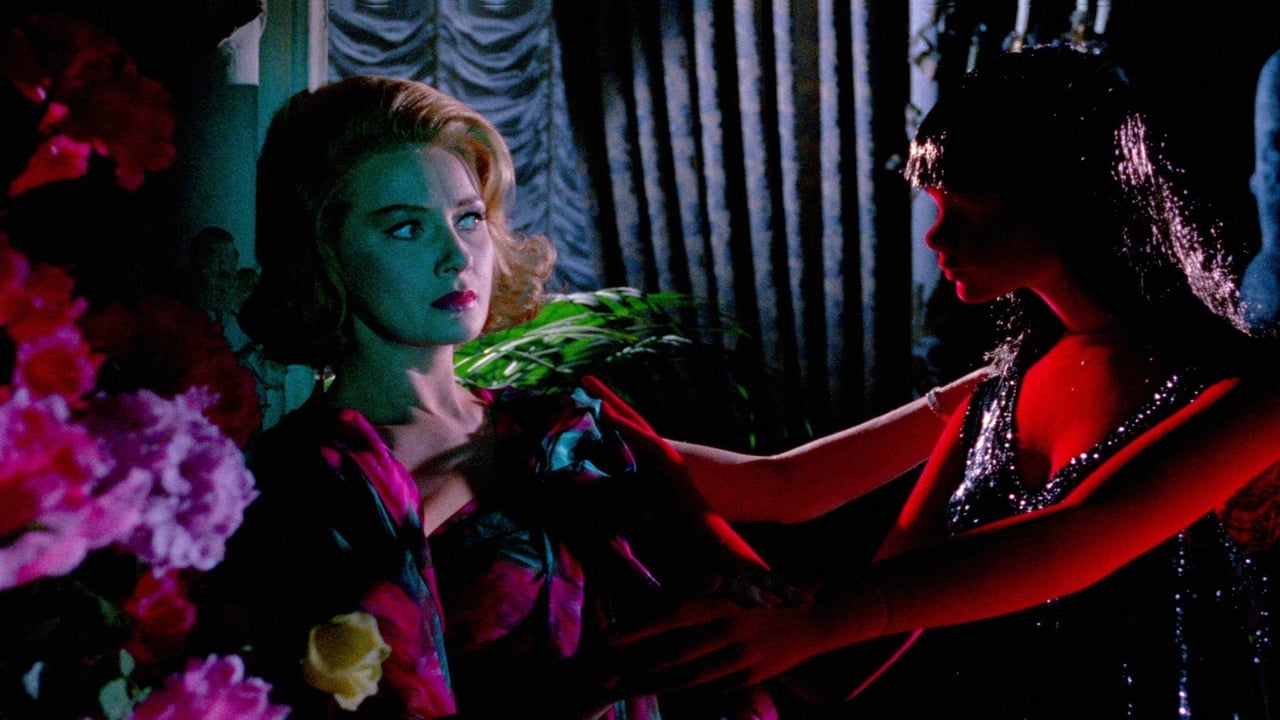thelastblogontheleft
Holy crap, this freakin' movie. So fantastic. It's considered to be one of the earliest and most influential of all giallo films and is said to have inspired filmmakers such as Tarantino and Argento. It's kind of a big deal.The director, Mario Bava, had already had worldwide commercial success with his two previous films (Black Sunday in 1960 and Black Sabbath in 1963), so he was given creative control over this one. He was "bored by the mechanical nature of the whodunit", so he chose to emphasize more of the horror and sex in the film. It had a fairly low budget of $150,000 and while it tanked in Italy (grossing only about $77,000), it has since been revered as one of the horror and mystery classics.One of the best things about the movie is the use of color and light. It's downright decadent, and a huge shift from his previous black & white films. The plot may not be the most complex and original, but the tension is palpable throughout the entire movie, and I was glued to the screen for the entirety, trying to guess who the killer was. The killings themselves are very intimate and personal, each one a little different than the last. Not overly gory -- I don't consider any killings with such obviously fake, bright red blood to be that bad -- but still disturbing all the same. But ultimately it's the tense paranoia of this film that keeps you pulled in. I loved it!
Scott LeBrun
Isabella (Francesca Ungaro), one of the lovely young models at a fashion house, meets a gruesome demise in this films' opening minutes. When her former co-workers rifle through her belongings, a diary is discovered. And many characters are mighty anxious to find out what Isabella might have written in there. Meanwhile, people continue to be murdered, and there's no shortage of suspects."Blood and Black Lace" was an early example of that beloved Italian genre of murder mysteries known as "Gialli", and as such, it's pretty good of its kind. Some viewers could find it a little hard to stomach, because it's rather brutal. Our murderer employs various methods, but always displays a certain sadism. The story & screenplay (by Marcello Fondato, in collaboration with director Mario Bava and Giuseppe Barilla) are not great, but they are reasonably involving and do try to keep you on your toes. The real drawing card, as with any film by Bava, is his visual style. His creation of images, and the colorful lighting and props, rank right up there with the best of his work. Things begin on an effectively ominous note, with a close-up on a sign that comes loose due to a heavy storm. As Bava well knows, dark and stormy nights are a classic trope of the entire horror genre.The acting is generally acceptable, with American actor Cameron Mitchell in the lead. Standing out among this cast are the sultry Eva Bartok as the Contessa, and Dante DiPaolo as drug-addicted Frank Sacalo. Other familiar faces include Luciano Pigozzi (the Italian Peter Lorre), Lea Lander ("Rabid Dogs"), and Harriet Medin ("The Whip and the Body"). As fans of the Giallo come to expect, much of the female cast is strikingly sexy and used to full advantage.Some Bava fans regard this as his true masterpiece.Seven out of 10.
jadavix
This is another thoroughly underwhelming horror entry from Mario Bava, injudiciously praised because of it coming so early in the giallo canon. If it had been released ten years later, you never would have heard of it.The movie is set in (and indeed, never leaves) a fashion house where, of course, the models are the victims of a masked killer. There is no reason for the killer to wear a mask; if anything this would make the job more difficult. They would be spotted so much more easily by anyone who happened on the scene. The mask is, of course, only worn to surprise the audience when we find out who the killer really is.Not that it really works as a surprise.The movie has no characters who make any kind of impression, and certainly no one we care about. Its many shots of mannequins invite unfavourable comparisons between these dummies and the women that sometimes stand in front of the camera. The mid sixties release date means that the movie isn't particularly violent and there is no nudity or sex. There is a mention of - shock, horror - drug abuse that is accompanied by some raucous strains on the soundtrack as if the mere word "cocaine" should be enough to send us into palpitations.Nothing else in the movie will have that effect on you. There's no tension, or surprise, or shocks whatsoever. When the killer is revealed, it's not even much of a surprise.
MARIO GAUCI
Rewatching this in close proximity to Bava's initial forays into the "Giallo" subgenre, namely THE GIRL WHO KNEW TOO MUCH and the "Il Telefono" segment from THE THREE FACES OF FEAR (both 1963), I was reminded of the late esteemed British film critic Leslie Halliwell's opening comments in his capsule review of James Whale's BRIDE OF FRANKENSTEIN (1935) – where he states that, while the 1931 original was "startlingly good", the follow-up proved a "sophisticated masterpiece". This was only the fourth effort by the director that had come my way back when I first got the opportunity to check it out in 1998 – via a late-night Italian TV screening exhibiting a print so battered that, at times, it was almost devoid of colour (such a vital factor to the director's aesthetic)! Unlike the preceding three Bava viewings, I recall loving this one immediately regardless, and it remains even now my personal favourite of his oeuvre
While there are definite links to the contemporaneous "Krimi" trend (this was, in actual fact, a German co-production) and the work of Alfred Hitchcock (the technical dexterity, audience manipulation, and even having the murderer repeatedly 'clean up' after his misdeeds – like Anthony Perkins in PSYCHO {1960}), there is so much groundwork here for subsequent entries in the field that one cannot stress too much the film's impact on the development of the thriller genre worldwide
however, without it ever seeming an outmoded prototype or coming across as a stuffy history lesson. Until the advent of Dario Argento, ushering in the new decade with greater emphasis on baroque violence and ostentatious camera gymnastics (not that Bava was one to be kept lagging behind – promptly responding with the "Slasher" template A BAY OF BLOOD {1971}!), this was the film to emulate
but, by and large, the initial results were not very encouraging. The director himself was wise not to play his hand too frequently – so that he made all of five and one-third contributions to the "Giallo" format during his career, unlike Argento's 15 (albeit over a much longer timespan)! Anyway, it is all pretty much laid down here already: the black-gloved killer, the fashion-house setting, the Police procedural, a variety of suspects (each determined to safeguard a terrible secret), the suggestion of misogyny (rendered unequivocal by the original Italian title – which translates to "Six Women For The Murderer"!), the splash of colours (including – inevitably – crimson), the creative murder weapons, the tantalizing soundtrack (to my mind, this constitutes Carlo Rustichelli's finest hour), not to mention the twist in the tail (which was still being ripped off more than 30 years later by the likes of Wes Craven!). Incidentally, I own two DVDs of the movie: VCI's initial single-disc U.S. release and the German company Hande Weg's edition: both are satisfactorily stacked with supplements (though the majority of the latter are, alas, not English-friendly!) but the image is superior on the R2 effort. Bava's mise-en-scene here is near-perfection, letting the camera prowl the various sets in search of nail-biting suspense situations (notably a woman's handbag containing an incriminating diary being left unattended on a table during a fashion show and then disappearing while props are being moved around in the atelier) or the next display of sadistic – but not gloating – violence (indeed, seldom has death been so enthusiastically arranged or lovingly photographed on screen!).With this in mind and as had been the case with Bava's Gothic Horror debut BLACK Sunday (1960), given such a seminal title, one tends to overlook any flaws (which may be down to plot logic – why, if everyone fears what the diary could expose of their various foibles, do the other characters not try to get hold of it like the killer? – or insubstantial characterization – admittedly, always a pitfall where ensembles are concerned). The cast is peppered with regulars of the director's work (Cameon Mitchell, Dante Di Paolo, Massimo Righi, Franco Ressel, Luciano Pigozzi and Harriet White Medin), but also such new 'recruits' as leading lady Eva Bartok and Lea Lander (who would subsequently prove instrumental in bringing Bava's unfinished RABID DOGS {1974} to light!).



 AD
AD













